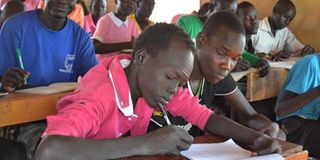Schooling crisis at Kakuma as refugee numbers increase

Pupils at Peace Primary School, Kakuma refugee camp, Turkana. Headteacher Michael Tot Ruot says the institution, like most others there, is congested, with about 7,000 pupils and a mere 44 teachers. PHOTO | OUMA WANZALA |
What you need to know:
- Turkana governor alarmed by rise in child labour and school drop-outs.
- Classrooms, toilets, desks and playing areas over-stretched, with insufficient teaching taking place.
An influx of refugees is straining already overcrowded schools in Kakuma, Turkana County.
Schools in the refugee camp are finding it hard to accommodate extra students from war-torn Somalia and South Sudan. Classrooms, toilets, desks and playing areas are overstretched, with insufficient teaching taking place.
The alarm was raised by Green Light Secondary School deputy principal Edward Omondi.
“A large number of students want to come to school but there is no space for them. We have already talked to our donors to provide more classes so that these young people can access education,” he said.
Mr Omondi said teachers have a big challenge dealing with children from different backgrounds, with many learners dropping out due to early marriages. “The most affected is the girl-child. Out of every 1,000 students, only about 100 are girls,” said Mr Omondi.
Peace Primary School, which is also among the several learning institutions at the camp, is facing similar challenges.
Head teacher Michael Tot Ruot told the Sunday Nation that the institution is congested, with about 7,000 pupils and a mere 44 teachers. He said the teachers have a hard time attending to all the learners.
“It is hard to manage such a huge number of pupils. But we work as a team and we are not doing badly,” he said, adding that some classes have as many as 300 pupils.
The school has also been hit by early marriages.
CHILD LABOUR
Turkana County Governor Josphat Nanok wants the United Nations refugee agency to step in and ensure that all children in the camp attend school. Speaking during the World Refugee Day recently, Mr Nanok raised concern over increased child labour.
“About 56 per cent of all refugees are children, the majority of whom are not in school but are engaging in child labour,” said Mr Nanok.
The camp, which was started in 1992, is home to 188,000 refugees. The County Government of Turkana has provided an additional 1,500 hectares of land for its expansion.
Statistics from UNHCR Kenya indicate that the camp has nine pre-schools, with an enrolment of 6,406 children. About 3,076 are girls, with only 24 per cent of eligible children aged 3-5 years in class.
There are 19 primary schools, including two emergency schools, with an enrolment of 44,004 children. Of these, 19,110 are girls.
The management of the camp has attributed the increase in student numbers to a high influx of refugees from South Sudan and introduction of a double-shift school system, with more space available for additional enrolment.
The teacher-pupil ratio at the camp is 1:105; the classroom-pupil ratio is 1:120 and the desk-pupil ratio is 1:8.
The camp has four secondary schools and an enrolment of 3,086 students, out of whom 640 are girls. The increase is attributed to expansion of secondary space due to the opening of two additional schools in 2014.
Some 1,018 students are in vocational and tertiary institutions, 343 of whom are female. One such institution is Don Bosco Vocational Training Centre, which has 40 students; eight of them girls.
Another challenge faced is a high population of over-age learners, at 54 per cent of total enrolment.
There is also an insufficient number of teachers, especially female tutors.
Other hurdles include limited training and teacher support opportunities.




